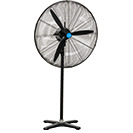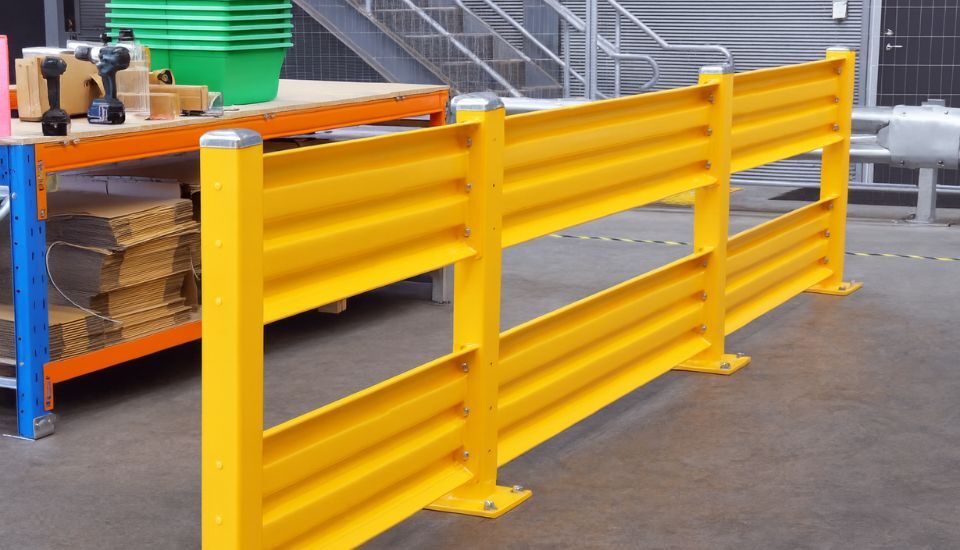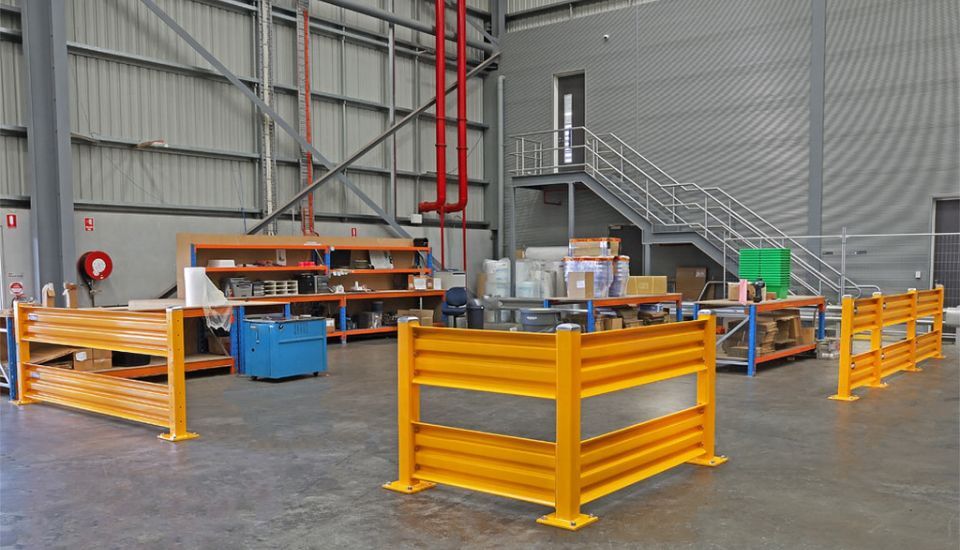5 Reasons Why Safety Barriers Are Critical For Warehouse Safety and Compliance
Date Posted:25 August 2025
Accidents are costly, and better safety means better business. Find out why safety barriers are a must for protecting warehouses, workers, equipment, and compliance.
Verdex Insights: At a Glance
-
The Challenge: Busy warehouses face constant collision risks between pedestrians and mobile plant, plus frequent impacts on racking and infrastructure. Incidents drive injuries, downtime, repairs, and WHS exposure.
-
The Insight: Purposeful use of safety barriers separates people and vehicles, protects assets, streamlines traffic flow, and supports compliance. Clear zones and edge protection improve productivity and worker confidence.
-
The Verdex Solution: Verdex supplies WHS-compliant traffic barriers, guardrails, bollards, rack protectors, and edge protection for warehousing, logistics, and manufacturing sites. Our durable systems help reduce accidents, protect equipment, and maintain efficient, compliant operations.
Why Safety Barriers Are Critical For Warehouse Operations
Warehouses are busy environments, where goods are stored, processed, and shipped out at a rapid pace. With forklifts, pallet jacks, and other heavy machinery constantly in motion, the potential for accidents and injuries is a serious concern.
To mitigate these risks, many warehouses are incorporating safety barriers as a vital component of their operations. These barriers serve as both physical and psychological safety measures, ensuring that workers are protected from hazards while enhancing overall operational efficiency.
In this blog, we’ll explore 5 reasons why safety barriers are essential for warehouse operations and how they can contribute to a safer and more productive environment.
1. Preventing Worker Injuries
The primary role of safety barriers and bollards in any warehouse is to protect workers from potential accidents. With various vehicles, heavy equipment, and personnel moving through the warehouse, the risk of collisions and accidents is always present. Safety barriers are a reliable material handling equipment that act as a crucial safeguard, ensuring that employees are kept out of harm’s way.
How Safety Barriers Help
-
Separation of Pedestrian and Vehicle Traffic: Safety barriers clearly delineate areas where forklifts, pallet trucks, and other machinery can operate, preventing accidental collisions between workers and machines.
-
Protection from Falling Items: In areas where goods are stored at height, safety barriers can prevent workers from coming into contact with falling items, which are a common cause of injuries in warehouses.
-
Defining Hazardous Zones: High-risk areas, such as loading docks, machinery zones, and heavy-duty storage areas, can be clearly marked with barriers to ensure workers remain outside of these potentially dangerous spaces.
By preventing accidents before they occur, safety barriers help reduce the risk of workplace injuries, which ultimately leads to fewer workers’ compensation claims, reduced downtime, and a more efficient operation.
2. Enhancing Operational Efficiency
While the primary focus of safety barriers is to protect workers, they also play an essential role in enhancing warehouse efficiency. By helping to organise the layout of the warehouse, safety barriers can guide the flow of operations, improving productivity.
Benefits to Efficiency
-
Streamlined Workflow: Safety barriers help define clear pathways for pedestrians and vehicles, which reduces confusion and keeps the flow of goods moving smoothly. When the work environment is well-organised, tasks can be completed more quickly and safely.
-
Traffic Control: In busy warehouses, the movement of forklifts and other vehicles can become chaotic. Safety barriers guide vehicle traffic and ensure that forklifts are operating in designated areas, reducing the likelihood of accidents and improving traffic flow.
-
Preventing Unnecessary Delays: By keeping workers safe from potential hazards, safety barriers prevent the need for emergency responses, investigations, and possible disruptions to work. A safe environment means fewer delays and an overall boost in productivity.
By creating an organised and controlled environment, safety barriers contribute to a more efficient warehouse, enabling employees to focus on their tasks without distraction or fear of injury.
3. Protecting Infrastructure and Equipment
Warehouses often contain valuable equipment, machinery, and inventory that are vital to business operations. Without proper safety measures in place, these items can become damaged in the event of a collision or accident. Safety barriers act as protective buffers, reducing the risk of damage to the warehouse infrastructure.
How Safety Barriers Protect Assets
-
Shielding Racking Systems: Warehouses rely on heavy-duty racking systems to store products. Forklifts and other vehicles can occasionally collide with these racks, leading to structural damage. Safety barriers placed around these areas prevent such incidents, ensuring that your racking systems remain intact and functional.
-
Safeguarding Machinery: High-cost machinery such as forklifts, conveyors, and automated systems are expensive to repair or replace. Installing safety barriers around these machines provides an extra layer of protection, preventing accidental damage and reducing maintenance costs.
-
Minimising Property Damage: Safety barriers help protect walls, doors, and loading docks from accidental impacts by forklifts or other vehicles, preventing costly repairs and extending the life of warehouse infrastructure.
Safety barriers not only protect workers but also safeguard your investment in valuable infrastructure and equipment, contributing to a more cost-effective warehouse operation.
4. Compliance with Safety Regulations
Safety is a key concern in every workplace, and warehouses are no exception. Regulations surrounding workplace safety are stringent, and failure to comply with safety standards can result in hefty fines, shutdowns, and reputational damage. Safety barriers are a key component in ensuring that a warehouse meets these regulatory requirements.
How Safety Barriers Help with Compliance
-
Adherence to Australian Workplace Safety Standards: Safety barriers help warehouses comply with Australian workplace safety regulations, such as the Work Health and Safety Act 2011, by providing physical safeguards that protect workers from injuries.
-
Reducing Liability Risks: By implementing safety barriers, warehouse operators reduce the risk of workplace accidents and injuries. This not only enhances employee wellbeing but also lowers the likelihood of legal action from injured workers.
-
Ensuring Load and Pedestrian Safety: Compliance with regulations often involves ensuring that pedestrian and vehicle traffic are safely separated. Safety barriers are effective in meeting these standards by physically enforcing designated walkways and restricted areas for equipment.
By investing in safety barriers, warehouses ensure that they comply with relevant safety regulations, reducing the risk of fines and legal complications, while fostering a culture of safety.
While PPE and workplace safety signage support compliance, safety barriers remain one of the most effective measures for meeting regulatory standards and protecting workers.
5. Psychological Safety and Employee Wellbeing
In addition to the physical safety benefits, safety barriers play an important role in the psychological wellbeing of warehouse workers. When employees feel safe in their work environment, their morale and job satisfaction improve, leading to higher productivity and lower turnover.
Psychological Benefits of Safety Barriers
-
Clear Safety Boundaries: Safety barriers provide visible and tangible markers that separate workers from hazardous areas. This clear distinction helps employees feel more secure, as they can easily identify which areas are safe to walk through and which are restricted.
-
Confidence in Workplace Safety: Knowing that appropriate safety measures, such as barriers, are in place instills confidence in employees. When workers feel that their safety is a priority, they are more likely to focus on their tasks and perform at their best.
-
Reducing Stress and Anxiety: The constant threat of accidents can cause anxiety among workers. Safety barriers alleviate this stress by creating a more predictable and secure environment, allowing employees to concentrate on their jobs without fear of injury.
In essence, safety barriers contribute not just to physical safety but to the overall mental health of workers, fostering a positive and productive work environment.
In addition to barriers, complementary measures such as workplace first aid kits further reassure employees that their safety is taken seriously, strengthening both confidence and wellbeing.
Types of Safety Barriers for Warehouse Operations
There are several types of safety barriers designed to address specific needs within a warehouse. The choice of barrier depends on the nature of the warehouse, the layout, and the type of hazards present.
Common Types of Safety Barriers
-
Traffic Barriers: Used to separate pedestrian walkways from vehicle pathways, these barriers prevent collisions between pedestrians and moving vehicles.
-
Rack Protectors: Specifically designed to protect shelving units and racking systems from forklift impacts, rack protectors are a vital tool for preventing damage to storage systems.
-
Edge Protection Barriers: Installed around loading docks and high-risk areas, these barriers help prevent workers from falling or being struck by vehicles.
-
Column Protectors: Placed around structural columns, these barriers protect both the columns and the vehicles from impact damage.
-
Fencing and Guardrails: Used to secure restricted areas or hazardous zones, fencing and guardrails ensure that employees are kept at a safe distance from high-risk operations.
Each of these barriers serves a specific function and can be strategically placed throughout the warehouse to ensure maximum safety.
Create a Safer Warehouse Today
Safety barriers are essential in creating a secure, efficient, and compliant warehouse environment. They not only protect workers from injuries and accidents but also safeguard valuable equipment, ensure compliance with safety regulations, and promote a productive and positive work culture.
By investing in the right safety barriers for your warehouse, you can reduce the risk of accidents, prevent damage to infrastructure, and enhance overall operational efficiency.
To learn more about safety barriers and how they can be helpful for your business, get in touch with the team at Verdex.
-
Email our team at sales@verdex.com.au
-
Or submit your enquiry through our online contact form
































































































































 Trolleys & Hand Trucks
Trolleys & Hand Trucks Cage Trolleys
Cage Trolleys Cleaning Carts & Trolleys
Cleaning Carts & Trolleys Construction Trolleys
Construction Trolleys Custom Trolleys
Custom Trolleys Hand Trucks & Dollies
Hand Trucks & Dollies Laundry/Linen Trolleys
Laundry/Linen Trolleys Lifting Trolleys
Lifting Trolleys Order Picking Trolleys
Order Picking Trolleys Panel Cart Trolleys
Panel Cart Trolleys Platform Trolleys
Platform Trolleys Powered Trolleys
Powered Trolleys Shelf & Tiered Trolleys
Shelf & Tiered Trolleys Shopping Trolleys
Shopping Trolleys Stainless Steel Trolleys
Stainless Steel Trolleys Tool Trolleys
Tool Trolleys Utility & Service Carts
Utility & Service Carts Lifting & Handling Equipment
Lifting & Handling Equipment Forklift Attachments
Forklift Attachments Jib Attachments
Jib Attachments Lifting Hoists & Pallet Hooks
Lifting Hoists & Pallet Hooks Load Skates & Tow Tugs
Load Skates & Tow Tugs Manual Stackers & Lifters
Manual Stackers & Lifters Pallet Jacks
Pallet Jacks Pallet Lifters
Pallet Lifters Pallet Rotators & Dispenser
Pallet Rotators & Dispenser Powered Pallet Trucks & Electric Lifters
Powered Pallet Trucks & Electric Lifters Scissor Lift Trolleys and Tables
Scissor Lift Trolleys and Tables Conveyor Equipment
Conveyor Equipment Conveyor Frames & Stands
Conveyor Frames & Stands Roller & Skate Conveyors
Roller & Skate Conveyors Ladders & Access Equipment
Ladders & Access Equipment Container & Yard Ramps
Container & Yard Ramps Ladders & Step Stools
Ladders & Step Stools Work Platforms & Crane Cages
Work Platforms & Crane Cages Drum Handling Equipment
Drum Handling Equipment Drum Storage & Bunding
Drum Storage & Bunding Drum Trolleys & Lifters
Drum Trolleys & Lifters Forklift Drum Handling
Forklift Drum Handling Waste Handling & Bins
Waste Handling & Bins Bin Lifters & Tippers
Bin Lifters & Tippers Plastic Waste & Wheelie Bins
Plastic Waste & Wheelie Bins Steel Waste & Tipping Bins
Steel Waste & Tipping Bins Waste Carts
Waste Carts Dangerous Goods Storage & Spillage
Dangerous Goods Storage & Spillage Aerosol Cans Storage Cages
Aerosol Cans Storage Cages Bunded Pallets & Storage
Bunded Pallets & Storage Corrosive Goods Storage Cabinets
Corrosive Goods Storage Cabinets DG Storage & Trolleys
DG Storage & Trolleys Flammable Liquid Cabinets
Flammable Liquid Cabinets Forklift Gas Storage Cages
Forklift Gas Storage Cages Site Storage
Site Storage Spill Kits
Spill Kits Shelving & Storage Equipment
Shelving & Storage Equipment Stillage & Transport Cages
Stillage & Transport Cages 750 Series Cage Configurations
750 Series Cage Configurations Heavy Duty Cabinets
Heavy Duty Cabinets Heavy Duty Shelving
Heavy Duty Shelving Mega Bins & Pallets
Mega Bins & Pallets Packing & Workbenches
Packing & Workbenches Parts Trays & Stor-Pak Bins
Parts Trays & Stor-Pak Bins Pegboard & Louvre Panels
Pegboard & Louvre Panels Plastic Bins & Crates
Plastic Bins & Crates Plastic Handling Solutions Bins
Plastic Handling Solutions Bins Plastic Pallets
Plastic Pallets Stack & Nest Bins
Stack & Nest Bins Pallet Racking Accessories
Pallet Racking Accessories Workplace Equipment
Workplace Equipment Modular Workbenches
Modular Workbenches Electric Height-Adjustable Workbenches
Electric Height-Adjustable Workbenches Floor Matting
Floor Matting General Workplace Equipment
General Workplace Equipment Industrial Weighing Scales
Industrial Weighing Scales Packaging Machinery
Packaging Machinery Stationery Cupboards
Stationery Cupboards Storage and Stillage Cages
Storage and Stillage Cages Tool Trolleys
Tool Trolleys Tooling Cabinets
Tooling Cabinets Workshop Fans and Coolers
Workshop Fans and Coolers Safety Barriers, PPE & Signage
Safety Barriers, PPE & Signage Barriers & Bollards
Barriers & Bollards First Aid Equipment
First Aid Equipment Gloves, Knives and PPE
Gloves, Knives and PPE Signage
Signage Cleaning & Site Supplies
Cleaning & Site Supplies Cleaning Equipment
Cleaning Equipment Cleaning Trolleys
Cleaning Trolleys Rubbish Bins
Rubbish Bins Signs & Traffic Supplies
Signs & Traffic Supplies Construction Equipment
Construction Equipment Construction Trolleys
Construction Trolleys Waste Handling
Waste Handling General Site Equipment
General Site Equipment Concrete Equipment
Concrete Equipment Site Storage
Site Storage Lifting Equipment
Lifting Equipment Verdex Specials
Verdex Specials











